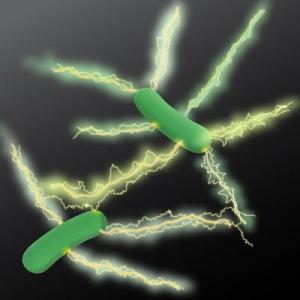The claim by microbiologist Derek Lovley and his colleagues at the University of Massachusetts Amherst that the microbe Geobacter produces nanowires has been the subject of a great deal of scientific debate over the last decade. Now a new collaborative study has provided strong evidence in accordance with their claims.
 UMass Amherst researchers recently provided stronger evidence than ever before to support their claim that the microbe Geobacter produces tiny electrical wires, called microbial nanowires, along which electric charges propagate just as they do in carbon nanotubes, a highly conductive man-made material. Credit: UMass Amherst
UMass Amherst researchers recently provided stronger evidence than ever before to support their claim that the microbe Geobacter produces tiny electrical wires, called microbial nanowires, along which electric charges propagate just as they do in carbon nanotubes, a highly conductive man-made material. Credit: UMass Amherst
Using a new imaging technique known as electrostatic force microscopy (EFM), the team were able to confirm the propagation of electric charge along microbial nanowires.
After electrons were injected at a specific locations in microbial nanowires, the entire filament started glowing as a result of the movement of electrons.
A similar effect can be observed in a carbon nanotube or any other highly conductive synthetic nanofilament.
This is the first application of the EFM technique to biological proteins. The flow of electric current via microbial nanowires has significant environmental and practical applications.
When the microbial species produce tiny nanowires, energy is generated and shared by converting waste into methane gas.
The nanowires enable the Geobacter species to grow on iron and other soil metals, causing a significant change to the chemistry of the soil. Microbial nanowires are considered the key factor involved in allowing Geobacter to generate electrical currents which can be applied in biological computing devices and microbial sensors.
Skepticism is good in science, it makes you work harder to evaluate whether what you are proposing is correct.
Derek Lovley, University of Massachusetts
There has been substantial skepticism about the electricity conduction of nanowires in Geobacter. This research, however, provides an insight on the charge propagation along the nanowires.
Electrons tend to move along discrete biochemical stepping-stones with individual electrons during propagation. However, in microbial nanowires, electrons are delocalised as they are in a copper wire for instance, thus developing metallic-like conductivity.
Although the phenomenon of metallic-like conductivity at different pH or temperatures in the microbial nanowires seemed to be clearly explained, many biologists still doubted the existence of the mechanism.
In order to resolve this, UMass Amherst researchers genetically changed the structure of the nanowire by eliminating the aromatic amino acids providing the delocalised electrons required for metallic-like conductivity using EFM.
It was evident from the imaging results that the flow of electric charge is facilitated even when the proteins are in native state, attached to the cells.
This technique also holds great promise for the development of protein-based nanoelectronics. This new research has been published in the Nature Nanotechnology journal.